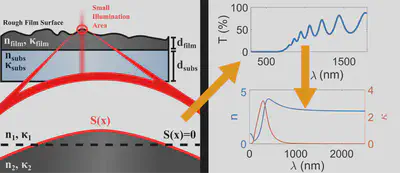
Our lab has developed multiple optimization-based inverse synthesis methods for characterizing the optical properties of thin film semiconductors using spectroscopic measurements taken from transmission spectrophotometers. Our methods are capable of accounting for errors in thin film preparation, such as surface tilts. For instance, we developed an optimization-based characterization method which uses a split-step angular spectrum propagator to model any geometrical properties of a thin film larger than an optical wavelength.
Additionally, our lab has expanded upon the “model-free” methods of characterizing semiconductors, derived from the famous Swanepoel method.